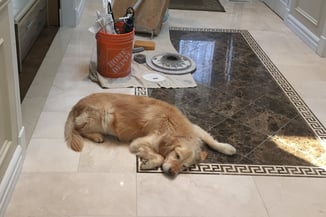FAQS - You've Got Natural Stone Care Questions... We've Got Answers
Q: My marble kitchen countertops have become dull, a little scratched and not looking great over time. I was never told proper stone care when they were installed, so how often should they be polished and sealed?
A: The frequency of polishing depends not just on the type of stone but also the type of marble that you have. Some marble surfaces are more forgiving and some marble surfaces are more prone to etching, scratching and chipping. It also depends on the usage. Generally, high-traffic areas like kitchen countertops may need deep cleaning and polishing every 1-2 years. Less-used areas can go a lot longer without attention. Regular cleaning and maintenance can also extend the time between polishing. If neglected for too long, or if there is extensive damage, a full restoration may be needed. Your countertops should be sealed after polishing.
Q: Can I polish my granite counters and marble floors myself, or should I hire a professional?
A: While you can purchase DIY marble and granite natural stone care kits, the bigger question is should you? Places like Amazon and Home Depot sell kits of varying (and some of dubious quality). The price for the whole kits tend to be less that the price of one professional diamond pad and they tend to make one type of pad for all types of stone, whether marble, granite, concrete or quartz. Because different types of stone have different behavioural characteristics, you cannot use the kits with a "one pads fits all types of uses" claims without causing damage. This should make us all question the reliability and the integrity of these kits, so tread very carefully. While some natural stone can be fairly straight forward to polish, to get predictable results you need to have the skill, learn the techniques and know what materials damage and etch stone, and which ones are safe. There are countless types and grades of stone and some look quite similar but behave quite differently when polishing. Countertops and vanities require a specialized hand machine (a drill might be adapted to help) and the floors require an even more specialized low speed floor machine. It takes years for a stone care restoration professional the learn the trade, so it is best to be careful with DIY.
Q: How do I remove stains from my natural stone countertops?
A: Successfully removing stains from natural stone depends on the type of stain, the type pf stone and the length of time it has been there. Just two weeks can be a lifetime for a stain. The longer the stain remains, the deeper it gets into the pores of the stone and the more difficult it becomes to remove. It is vitally important to identify the type of stain first and if possible, how long it has been there. For organic stains like coffee, food or wine, sometimes a poultice with baking soda and water may help. For oily stains, a mixture of acetone and baking soda can be effective on some types of stone. However, professional help may be needed for stubborn, deep-seated stains or unidentified stains.
Q: Can chips and cracks be repaired in natural stone countertops?
A: Yes, chips and cracks can often be repaired using epoxy or resin fillers and carefully colour-matching, grinding then polishing to blend in for near invisible results. It is essential to address these issues promptly to prevent further damage and to save any chipped or broken pieces.
Q: How long does the process of polishing marble take?
A: Small to medium restoration and polishing projects can take a half to a full day, while larger projects may take several days. To achieve a beautiful finished product, the steps include masking surrounding areas with plastic and waterproof tape, deep cleaning and performing any required stone repair like filling deep scratches and chips. Then, using high quality diamond resin pads in different grits so that a low or high honed finish ( a matte or satin finish respectively) or a high polished finish is achieved. A further polishing paste or polishing powder is then used to bring out more depth and clarity in the shine, then a neutralizing rinse and then sealing.
Q: What is the difference between honing and polishing, or do they mean the same thing?
A: A. Best practices of honing natural stone requires a combination of diamond resin pads and diamond impregnated pads to create a matte/flat finish (low hone) or a satin finish (high hone). A honed finish generally has less reflective shine depending on the stone type, but if done properly, it should still have depth and clarity and a natural non-plastic look. It should feel silky to the touch. Honing can make water-spots, mineral deposits etching and scratching less noticeable but the pores will be more “open” which can make it more susceptible to staining if unsealed. Highly polished stone may show scratches and etches more readily, but the stone's natural pores will be more “closed”, making the stone much more robust and durable so it resists scratches and etches.
Q: Can water damage be repaired on natural stone?
A: Water damage on natural stone can come in many forms. Water spots form when water gets into the pores of unsealed porous natural stone and can appear as darker areas. Removing the source of water and exposing it to air or a mild heat source can the evaporate the dark spots over time. Light coloured "water rings" may not be water damage at all, but may be the acidic etching of calcite-based stones (calcium carbonate) like marble. Polishing can correct this issue if it is mild but refinishing /restoration is required if it is moderate to severe. "Spalling" and "efflorescence" is a chronic pitting and flaking of natural stone due to moisture and water ingress. The trapped water dissolves mineral material as it moves through the stone and can cause severe damage with requires professional attention.
Q: How do I know if my natural stone requires re-sealing to protect it?
A: The simplest way to find out if your stone is unsealed or if your sealer has broken down and worn off is to do a water test. Place a few drops of water on the surface and wait 15 minutes. If the water is still present on the surface then your sealer is working. If the water has disappeared from the surface and the area where it was placed is now darker, then it is time to be resealed. This test can be replicated to test for oil-based absorption with a few drops of cooking oil but it recommended this only be done only on a scrap piece of your stone. In general, natural stone needs to be re-sealed every 1-3 years but it really depends on the type of stone, the usage and the quality of the sealer.
Q: Our piano was moved across our white Carrara Marble floor. The floor was refinished and the scratches, which we could actually feel, are now gone. There are still white marks left behind where the scratches were. Can this be fixed?
A: Due to the crystalline nature of white Carrara Marble, moving heavy objects across it can cause "stun marks" or "snow white marks". The actual calcium carbonate or calcite crystal structure has been damaged and fractured in a small area under the scratches. Even though the surface scratches can usually be resolved with polishing or restoration depending on the severity, there is no corrective measure to restore that localized crystalline structure of the stun marks.
Have More Stone Care Questions Or Need Some Tips?
Serving Toronto and the Surrounding GTA
Don't take your Floors, Countertops & Showers For Granite...
Have them professionally restored, sealed and maintained
437-429-2780
Call, Text or Contact Us NOW For A Quote


info@AndrewsProfessionalStoneCare.com
© Copyright 2023
Service Areas
Toronto & GTA
Oakville
Mississauga
Burlington
Markham
Vaughn
Thornhill
Richmond Hill
Woodbridge
Pickering
Ajax
